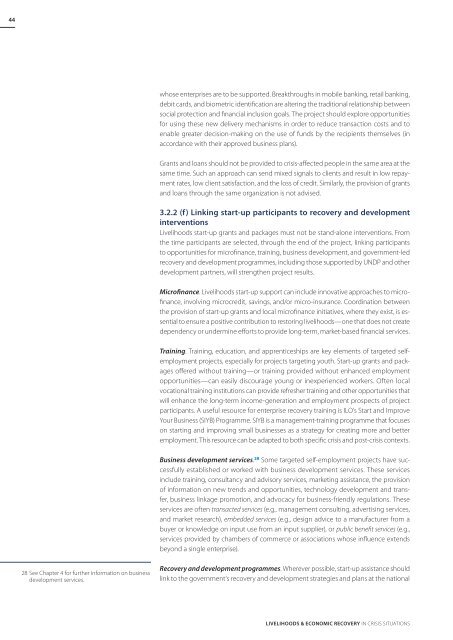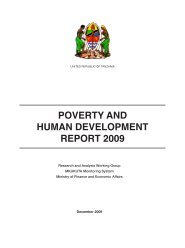Download PDF (4.08 MB) - ReliefWeb
Download PDF (4.08 MB) - ReliefWeb
Download PDF (4.08 MB) - ReliefWeb
You also want an ePaper? Increase the reach of your titles
YUMPU automatically turns print PDFs into web optimized ePapers that Google loves.
44<br />
whose enterprises are to be supported. Breakthroughs in mobile banking, retail banking,<br />
debit cards, and biometric identification are altering the traditional relationship between<br />
social protection and financial inclusion goals. The project should explore opportunities<br />
for using these new delivery mechanisms in order to reduce transaction costs and to<br />
enable greater decision-making on the use of funds by the recipients themselves (in<br />
accordance with their approved business plans).<br />
Grants and loans should not be provided to crisis-affected people in the same area at the<br />
same time. Such an approach can send mixed signals to clients and result in low repayment<br />
rates, low client satisfaction, and the loss of credit. Similarly, the provision of grants<br />
and loans through the same organization is not advised.<br />
3.2.2 (f) Linking start-up participants to recovery and development<br />
interventions<br />
Livelihoods start-up grants and packages must not be stand-alone interventions. From<br />
the time participants are selected, through the end of the project, linking participants<br />
to opportunities for microfinance, training, business development, and government-led<br />
recovery and development programmes, including those supported by UNDP and other<br />
development partners, will strengthen project results.<br />
Microfinance. Livelihoods start-up support can include innovative approaches to microfinance,<br />
involving microcredit, savings, and/or micro-insurance. Coordination between<br />
the provision of start-up grants and local microfinance initiatives, where they exist, is essential<br />
to ensure a positive contribution to restoring livelihoods—one that does not create<br />
dependency or undermine efforts to provide long-term, market-based financial services.<br />
Training. Training, education, and apprenticeships are key elements of targeted selfemployment<br />
projects, especially for projects targeting youth. Start-up grants and packages<br />
offered without training—or training provided without enhanced employment<br />
opportunities—can easily discourage young or inexperienced workers. Often local<br />
vocational training institutions can provide refresher training and other opportunities that<br />
will enhance the long-term income-generation and employment prospects of project<br />
participants. A useful resource for enterprise recovery training is ILO’s Start and Improve<br />
Your Business (SIYB) Programme. SIYB is a management-training programme that focuses<br />
on starting and improving small businesses as a strategy for creating more and better<br />
employment. This resource can be adapted to both specific crisis and post-crisis contexts.<br />
Business development services. 28 Some targeted self-employment projects have successfully<br />
established or worked with business development services. These services<br />
include training, consultancy and advisory services, marketing assistance, the provision<br />
of information on new trends and opportunities, technology development and transfer,<br />
business linkage promotion, and advocacy for business-friendly regulations. These<br />
services are often transacted services (e.g., management consulting, advertising services,<br />
and market research), embedded services (e.g., design advice to a manufacturer from a<br />
buyer or knowledge on input use from an input supplier), or public benefit services (e.g.,<br />
services provided by chambers of commerce or associations whose influence extends<br />
beyond a single enterprise).<br />
28 See Chapter 4 for further information on business<br />
development services.<br />
Recovery and development programmes. Wherever possible, start-up assistance should<br />
link to the government’s recovery and development strategies and plans at the national<br />
Livelihoods & Economic Recovery in Crisis Situations





